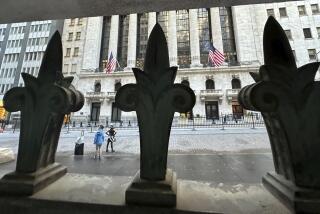Bonds Get Hit, but Pros Advise Waiting to Sell
- Share via
Bond mutual funds, reeling from some of their worst share price declines in recent memory, fear that small investors’ patience may be wearing thin.
So far, most fund companies say the rise in market interest rates that has clipped bond values has sparked only minor cash outflows from bond funds.
But as investors focus on the probability that interest rates have finally bottomed after declining for five years, the risk is that a large chunk of the $750 billion in bond funds could head for the exits.
Before you hurry to sell bonds today, however, many experts advise patience: There may be a better time to bail this spring, once the current panic subsides.
The market’s crisis began on Feb. 4, the day the Federal Reserve boosted short-term interest rates by a quarter-point. It was a signal from the Fed that it is serious about restraining the economy’s growth.
What few investors had counted on was that longer-term interest rates, over which the Fed has no real control, would spiral higher with the small rise in short rates.
The yield on 30-year Treasury bonds, for example, has shot up to 6.72% from 6.31% on Feb. 3. And intermediate-term yields have risen even more. The yield on five-year Treasury notes now stands at 5.65%, up from 5.19% just before the Fed’s shift.
In theory, long-term yields shouldn’t have been affected by the increase in short rates, because a moderately growing economy (the Fed’s goal) would check inflation and money demand--both of which should put downward pressure on long yields.
But the market hasn’t followed Wall Street’s script. Many professional bond investors have rushed to sell recently, driving yields up. Adding this latest rise to the spurt in long rates in November, bond yields now are nearly a full point above their October lows.
The result has been an erosion in bond funds’ share prices, because any rise in market interest rates devalues older fixed-rate bonds:
* The average bond fund that owns long-term U.S. government securities lost nearly 1% of its value in the seven days ended last Thursday, according to fund-tracker Lipper Analytical Services.
* Year-to-date, the average long-term U.S. government bond fund has posted a negative total return of 1.25%, Lipper calculates. Total return measures the interest earnings of a fund plus the net gain or loss in its share price.
So a negative total return of 1.25% means that, even though a fund has been earning interest, the decline in its share price has more than wiped out that interest.
* The negative total return so far this year follows a fourth-quarter net loss as well for many bond fund owners. Lipper says the average long-term U.S. government bond fund had a negative total return of 0.36% in the fourth quarter.
Funds that own shorter-term bonds also have suffered, though less so, as yields have risen across the board. The average total return on short-term U.S. government funds (which own bonds maturing in one to five years) is a negative 0.51% so far this year, Lipper says; intermediate-term government funds (5- to 10-year bonds) have lost an average 1.1%.
The bottom line: Few investors are making money in bond funds this year. What is unknown is how much individuals are willing to lose before they react.
But with long-term Treasury yields nearing 7%, and long-term corporate and mortgage-backed bond yields already over 7% again, some Wall Street pros believe rates are more likely approaching a near-term top than readying another big move up. This may be the wrong time to flee bonds.
The optimists say the recent dumping of bonds has mostly been the work of so-called hedge funds and other trigger-finger investors, who tend to exit any investment at the first sign of trouble.
The hedge funds’ selling of U.S. bonds also has been exacerbated by their need to unwind complex trades that have bombed, says William Dodge, investment strategist at Dean Witter in New York.
In one common such trade, many hedge funds shorted the Japanese yen (i.e., they bet that it would drop in value), Dodge says. When the yen instead began to appreciate against the dollar, the hedge funds were forced to raise cash to close out their positions. The easiest way to raise cash is to sell U.S. bonds.
As that selling tapers off, investors should come to realize that the economy isn’t hot enough to justify long-term rates much above current levels, Dodge and others say. That should allow long yields to ease again, at least slightly, going into the spring, they say.
Phil Barach, manager of the Enterprise Government Securities Fund in Los Angeles, says he figured the surprise early this year would be a sharp rise in long-term yields, so he positioned his fund accordingly. “But I think it’s overdone now,” he says.
With mortgage-backed bonds, such as Government National Mortgage Assn. issues, paying more than 7% again, that’s a 4% real return if inflation holds at a 3% annual rate, Barach says. “Fundamentally, that’s a pretty acceptable return,” he says.
Even so, some pros advise individuals who are heavy in long-term bond funds to gradually pare those holdings this spring, assuming rates come down again (and thus share prices rise). In a growing economy, with an “unfriendly” Fed, you’re better off keeping your money in short- or intermediate-term funds from now on, says William Griggs at investment firm Griggs & Santow in New York.
A 10-year Treasury note yields 6.20% now, Griggs says. A five-year T-note yields 5.65%. Considering the greater risk to the 10-year note’s principal if interest rates continue to rise, the five-year note is a far better deal, he says.
More to Read
Inside the business of entertainment
The Wide Shot brings you news, analysis and insights on everything from streaming wars to production — and what it all means for the future.
You may occasionally receive promotional content from the Los Angeles Times.










